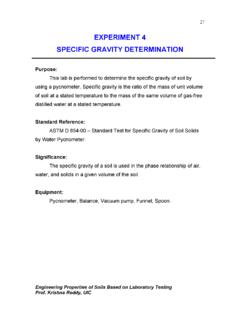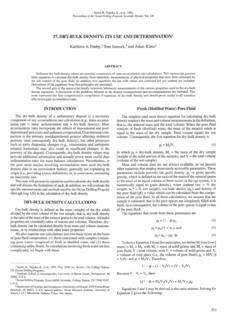Transcription of Porosity and Pore Size Distribution - USGS
1 REPRINT Nimmo, , 2004, Porosity and Pore Size Distribution , in Hillel, D., ed. Encyclopedia of Soils in the Environment: London, Elsevier, v. 3, p. 295-303. Porosity and Pore Size Distribution the medium. Thus we consider a single, con- J. R. Nimmo, Geological Survey, tiguous pore space within the body of soil. In Menlo Park, CA 94025, USA. general, the pore space has fluid pathways that Key Words: soil structure, aggregation, fractals, are tortuous, variably constricted, and usually soil hydraulic properties, hydraulic conductivity, soil highly connected. Figure 1 is an example of a water retention, hysteresis, tillage, soil compaction, two-dimensional cross section of soil pore solute transport. space. The pore space is often considered in terms A soil's Porosity and pore size Distribution of individual pores--an artificial concept that characterize its pore space, that portion of the enables quantifications of its essential charac- soil's volume that is not occupied by or iso- ter.
2 Though many alternatives could serve as a lated by solid material. The basic character of basis for the definition of pores and their sizes, the pore space affects and is affected by criti- in soil science and hydrology these are best cal aspects of almost everything that occurs in conceptualized, measured, and applied with the soil: the movement of water, air, and other respect to the fluids that occupy and move fluids; the transport and the reaction of chemi- within the pore space. cals; and the residence of roots and other biota. By convention the definition of pore space ex- cludes fluid pockets that are totally enclosed Porosity within solid material vesicles or vugs, for example, that have no exchange with the pore Porosity is the fraction of the total soil space that has continuity to the boundaries of volume that is taken up by the pore space. Thus it is a single-value quantification of the amount of space available to fluid within a specific body of soil.
3 Being simply a fraction of total volume, can range between 0 and 1, typically falling between and for soils. With the assumption that soil is a continuum, adopted here as in much of soil science litera- ture, Porosity can be considered a function of position. Porosity in natural soils The Porosity of a soil depends on several factors, including (1) packing density, (2) the breadth of the particle size Distribution (polydisperse vs. monodisperse), (3) the shape of particles, and (4) cementing. Mathemati- cally considering an idealized soil of packed Figure 1. Cross section of a typical soil with pore uniform spheres, must fall between and space in black. This figure would lead to an under- , depending on the packing. Spheres ran- estimate of Porosity because pores smaller than domly thrown together will have near the about mm do not appear. (Adapted from Lafe- ber, 1965, Aust. J. Soil Res., v. 3, p. 143.). middle of this range, typically to A. sand with grains nearly uniform in size 1.
4 REPRINT Nimmo, , 2004, Porosity and Pore Size Distribution , in Hillel, D., ed. Encyclopedia of Soils in the Environment: London, Elsevier, v. 3, p. 295-303. (monodisperse) packs to about the same poros- Porosity is often conceptually partitioned ity as spheres. In a polydisperse sand, the fit- into two components, most commonly called ting of small grains within the pores between textural and structural Porosity . The textural large ones can reduce , conceivably below component is the value the Porosity would the uniform-sphere minimum. Figure 2 have if the arrangement of the particles were illustrates this concept. The particular sort of random, as described above for granular mate- arrangement required to reduce to or rial without cementing. That is, the textural less is highly improbable, however, so also Porosity might be about in a granular me- typically falls within the for dium. The structural component represents polydisperse sands. Particles more irregular in nonrandom structural influences, including shape tend to have larger gaps between their macropores and is arithmetically defined as the nontouching surfaces, thus forming media of difference between the textural Porosity and greater Porosity .
5 In porous rock such as sand- the total Porosity . stone, cementation or welding of particles not The texture of the medium relates in a gen- only creates pores that are different in shape eral way to the pore-size Distribution , as large from those of particulate media, but also re- particles give rise to large pores between them, duces the Porosity as solid material takes up and therefore is a major influence on the soil space that would otherwise be pore space. Po- water retention curve. Additionally, the struc- rosity in such a case can easily be less than ture of the medium, especially the pervasive- , even approaching 0. Cementing material ness of aggregation, shrinkage cracks, worm- can also have the opposite effect. In many holes, etc. substantially influences water reten- soils, clay and organic substances cement par- tion. ticles together into aggregates. An individual aggregate might have a Porosity within it, Measurement of Porosity but the medium as a whole has additional pore The technology of thin sections or of to- space in the form of gaps between aggregates, mographic imaging can produce a visualiza- so that can be or greater.
6 Observed po- tion of pore space and solid material in a rosities can be as great as to in a peat cross-sectional plane, as in Figure 1. The (extremely high organic matter) soil. summed area of pore space divided by total area gives the areal Porosity over that plane. An analogous procedure can be followed along a line through the sample, to yield a linear po- rosity. If the medium is isotropic, either of these would numerically equal the volumetric Porosity as defined above, which is more usu- ally of interest. The volume of water contained in a satu- rated sample of known volume can indicate Porosity . The mass of saturated material less the oven-dry mass of the solids, divided by the density of water, gives the volume of water. This divided by the original sample volume gives Porosity . Figure 2. Dense packing of polydisperse An analogous method is to determine the spheres. (Adapted from Hillel, 1980, Fundamentals volume of gas in the pore space of a com- of soil physics, Academic Press, p.)
7 97.) pletely dry sample. Sampling and drying of 2. REPRINT Nimmo, , 2004, Porosity and Pore Size Distribution , in Hillel, D., ed. Encyclopedia of Soils in the Environment: London, Elsevier, v. 3, p. 295-303. the soil must be conducted so as not to com- press the soil or otherwise alter its Porosity . A. Pores and Pore-size Distri- pycnometer can measure the air volume in the bution pore space. A gas-tight chamber encloses the sample so that the internal gas-occupied vol- ume can be perturbed by a known amount The nature of a pore while the gas pressure is measured. This is Because soil does not contain discrete ob- typically done with a small piston attached by jects with obvious boundaries that could be a tube connection. Boyle's law indicates the called individual pores, the precise delineation total gas volume from the change in pressure of a pore unavoidably requires artificial, sub- resulting from the volume change. This total jectively established distinctions.
8 This con- gas volume minus the volume within the pis- trasts with soil particles, which are easily de- ton, connectors, gaps at the chamber walls, and fined, being discrete material objects with ob- any other space not occupied by soil, yields vious boundaries. The arbitrary criterion re- the total pore volume to be divided by the quired to partition pore space into individual sample volume. pores is often not explicitly stated when pores To avoid having to saturate with water or or their sizes are discussed. Because of this air, one can calculate Porosity from measure- inherent arbitrariness, some scientists argue ments of particle density p and bulk density that the concepts of pore and pore size should b. From the definitions of b as the solid be avoided. Much valuable theory of the be- havior of the soil-water-air system, however, mass per total volume of soil and p as the has been built on these concepts, defined using solid mass per solid volume, their ratio b / p widely, if not universally, accepted criteria.
9 Is the complement of , so that A particularly useful conceptualization takes the pore space as a collection of channels (1) = 1 b / p. through which fluid can flow. The effective Often the critical source of error is in the de- width of such a channel varies along its length. termination of total soil volume, which is Pore bodies are the relatively wide portions harder to measure than the mass. This meas- and pore openings are the relatively narrow urement can be based on the dimensions of a portions that separate the pore bodies. Other minimally disturbed sample in a regular geo- anatomical metaphors are sometimes used, the metric shape, usually a cylinder. Significant wide part of a pore being the belly or error can result from irregularities in the actual waist , and the constrictive part being the shape and from unavoidable compaction. Al- neck or throat . In a medium dominated by ternatively, the measured volume can be that textural pore space, like a sand, pore bodies of the excavation from which the soil sample are the intergranular spaces of dimensions originated.
10 This can be done using measure- typically slightly less than those of the adja- ments of a regular geometric shape, with the cent particles. At another extreme, a worm- same problems as with measurements on an hole, if it is essentially uniform in diameter extracted sample. Additional methods, such as along its length, might be considered a single the balloon or sand-fill methods, have other pore. The boundaries of such a pore are of sources of error. three types: (1) interface with solid, (2) con- striction a plane through the locally narrow- est portion of pore space, or (3) interface with another pore ( a crack or wormhole) or a hydraulically distinct region of space ( the land surface). 3. REPRINT Nimmo, , 2004, Porosity and Pore Size Distribution , in Hillel, D., ed. Encyclopedia of Soils in the Environment: London, Elsevier, v. 3, p. 295-303. This cellular, equivalent-capillary concep- tualization of pores is especially relevant to hydraulic behavior, as has been recognized for more than 70 years.




